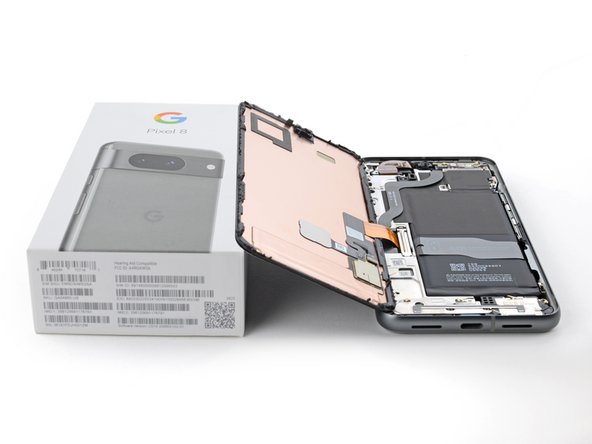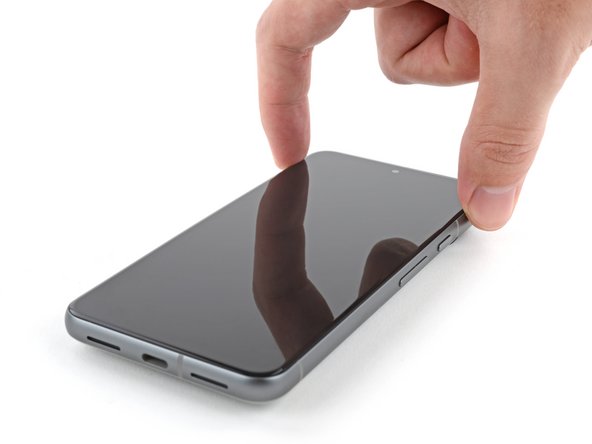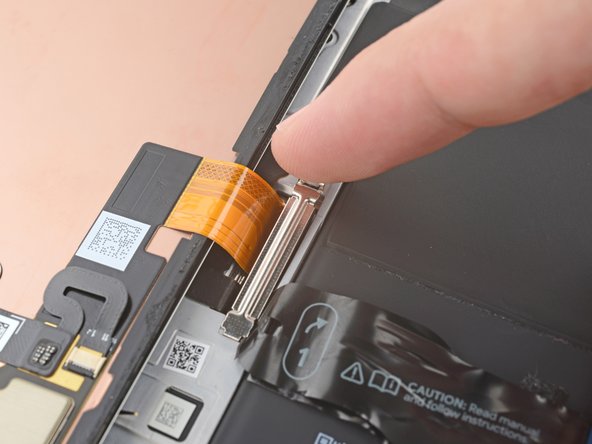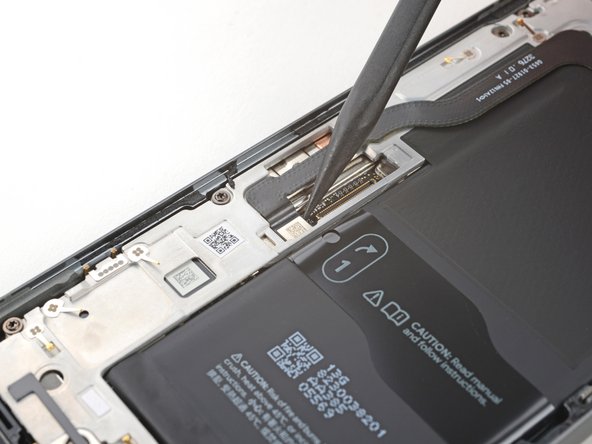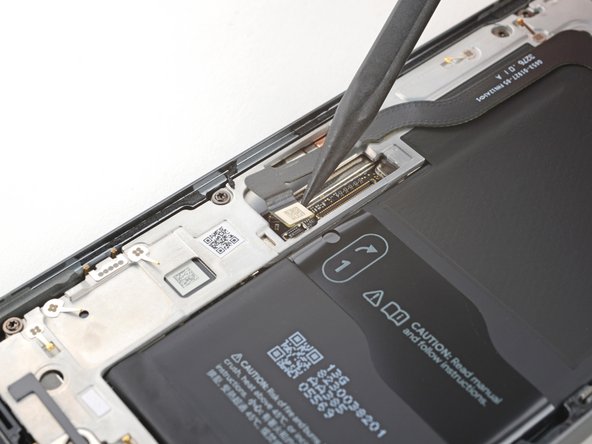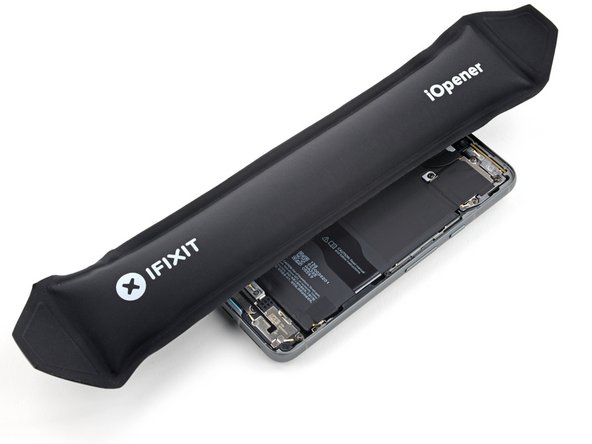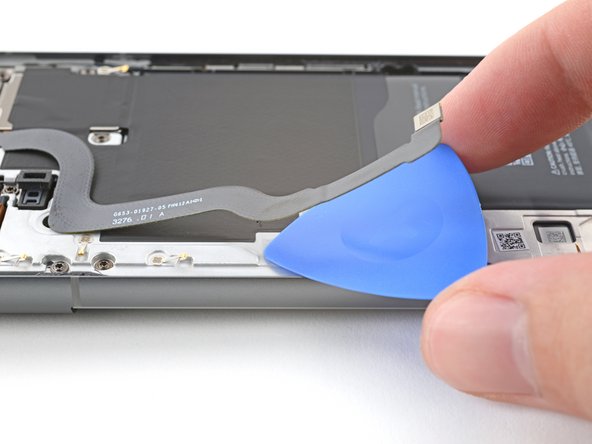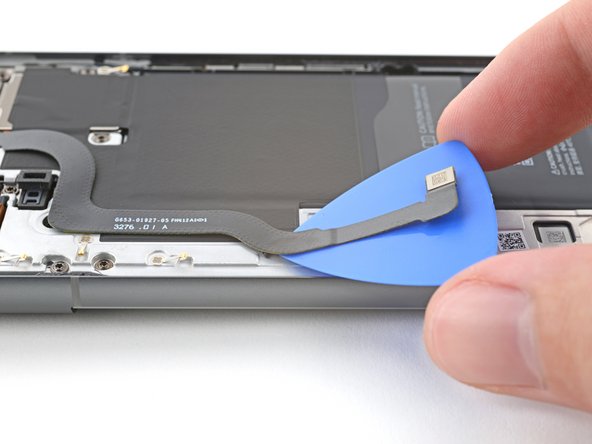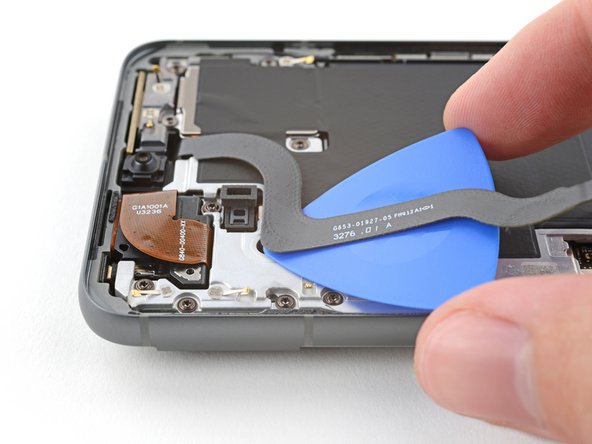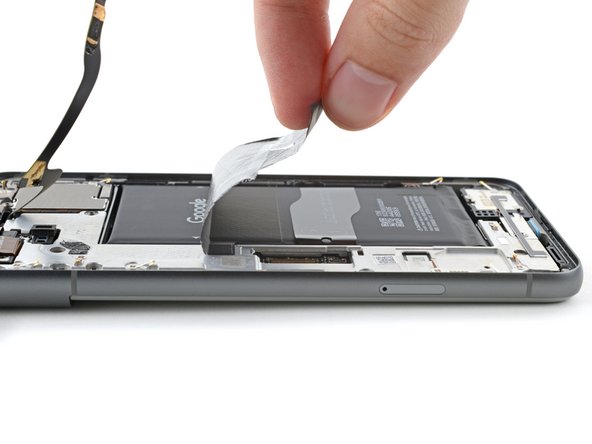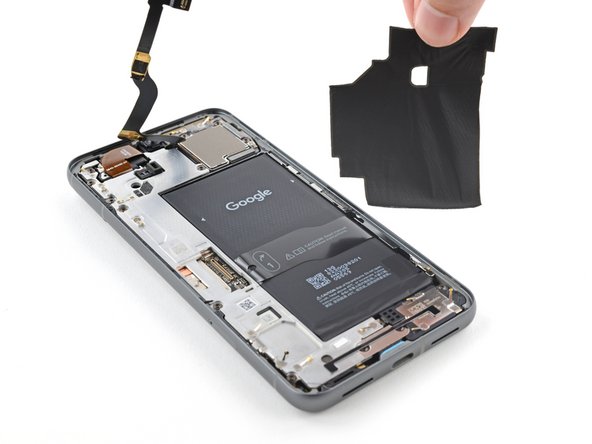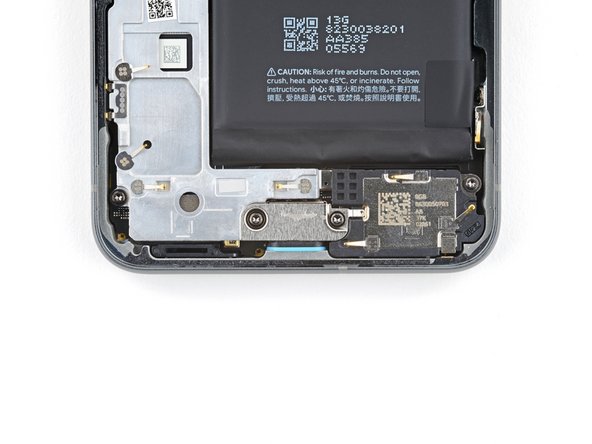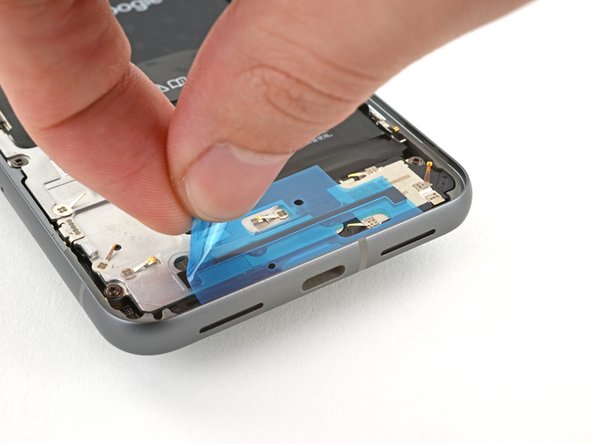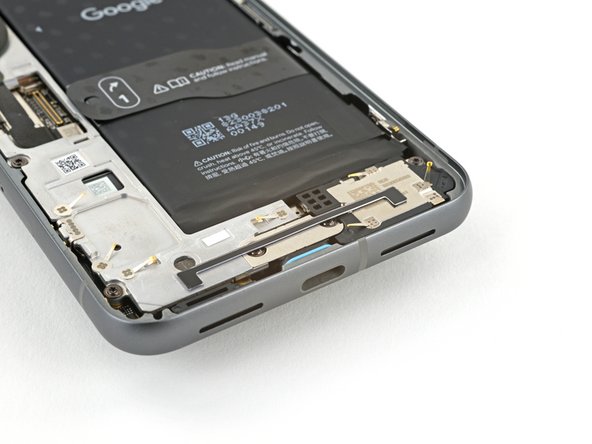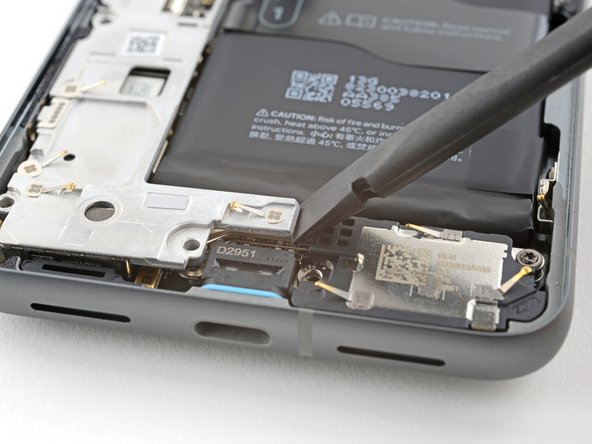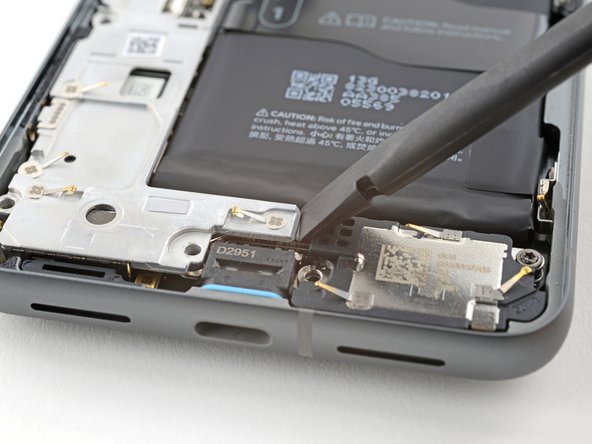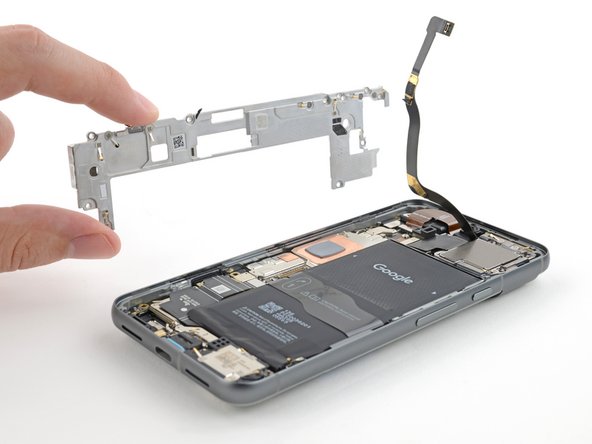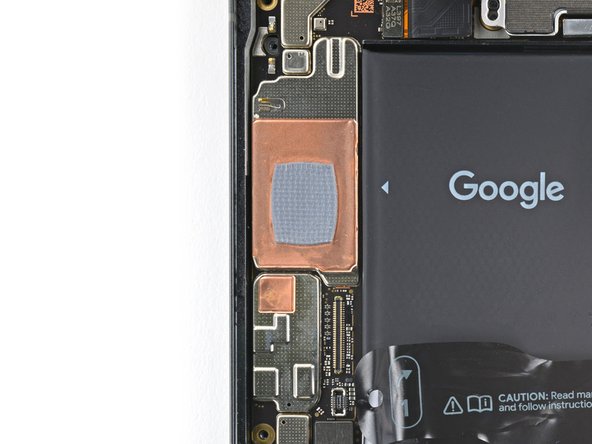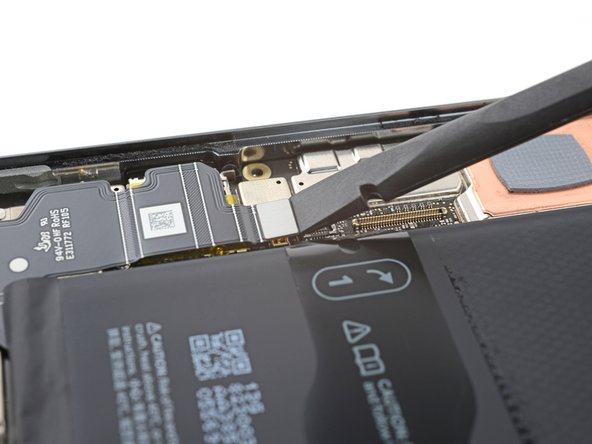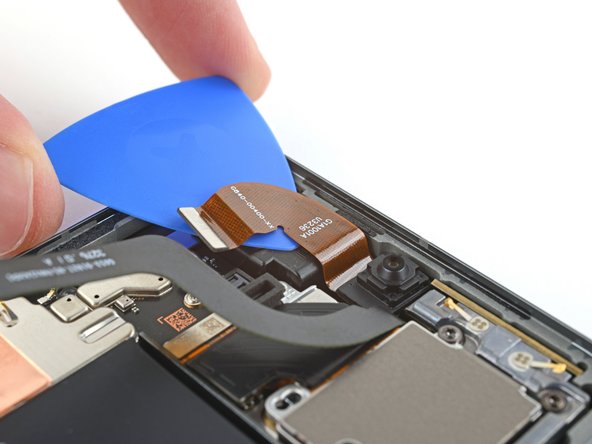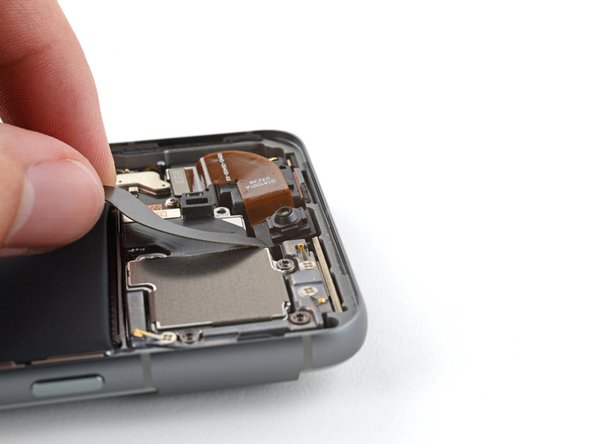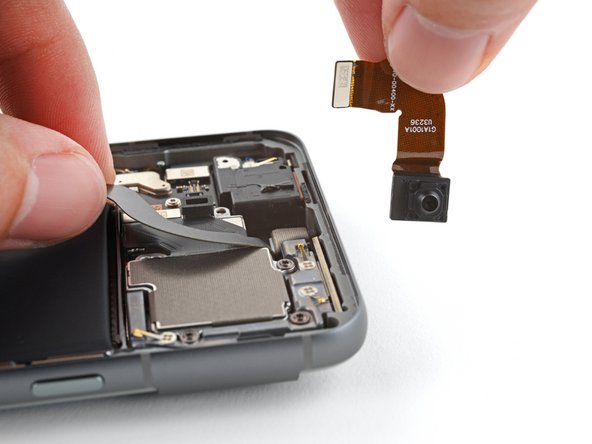Google Pixel 8 Front Camera Replacement Guide
Duration: 45 minutes
Steps: 39 Steps
This repair guide was crafted by the awesome crew at Salvation Repair. Learn more about our repair guideshere.
Welcome to your guide for swapping out the front camera on your Pixel 8! If your selfies are turning out fuzzy, spotted, or simply refusing to work, it might be time for a little camera TLC. Get ready to roll up your sleeves and grab some replacement screen adhesive to get the job done right. Just a heads up, this guide is tailored for the 5G mmWave version of the Pixel 8, but if you’ve got the non-mmWave model, no worries—just breeze past the steps mentioning the 5G mmWave antenna. If you need help, you can always schedule a repair.
Step 1
Before diving into this repair adventure, let your Pixel’s battery dip below 25%. A fully charged lithium-ion battery can be a bit dramatic if it gets damaged, and we definitely want to avoid any fiery surprises!
Give those power and volume up buttons a little love and press them together! This will pop up the shutdown menu, making it easy for you to get to the next step.
– First things first, let’s get your phone all unplugged! Disconnect those cables and give it some breathing room.
– Now, it’s time to power down! Make sure your phone is completely turned off so we can work our magic safely.
Step 2
Isn’t it neat how a simple coin can keep your tool on track? Make sure to keep that 3 mm distance to keep your gadget safe from harm. Don’t worry, we’ve all been there before!
– Hey there! So, you wanna mark that opening pick, right? Well, just 3 mm from the tip and make it pop with some marker fun! Doesn’t get much cooler than that! 😎🎨
Step 3
The screen is stuck to the frame with adhesive and clips, but don’t worry, it’s easier to remove than you think. Just apply some heat to soften the adhesive and you’ll be able to separate the screen in no time.
If you don’t have the right tools, you can use a hair dryer, heat gun, or hot plate to get the job done. Just be careful not to get too carried away with the heat, or you might damage the screen or battery. Take your time and you’ll be golden.
– Let’s get this repair started! Heat an iOpener and place it on the bottom edge of the screen for about two minutes. This will help loosen the adhesive, making the next steps a breeze.
Tools Used
Step 4
Get ready for some fun! The next three steps will show you how to use the Anti-Clamp, our nifty little tool that makes opening your device a breeze. If you don’t have the Anti-Clamp handy, no worries! Just skip down three steps for a different approach.
Want to master the Anti-Clamp? Check out this guide for all the details!
– Give that blue handle a little pull back to unleash the Anti-Clamp’s arms.
– Set your phone screen-side up on a flat surface, making sure it sits nicely in the arms of the Anti-Clamp—the bottom edge should be just hanging off for easy access.
– Gently slide the arms over the left edge of your phone to get a good look at the bottom edge.
– Position the suction cups as close to the center of the bottom edge as you can for optimal suction magic.
– Now, go ahead and squeeze those cups together to create a strong suction grip.
Step 5
– Gently pull the handle forward to secure those arms in place.
– Give the handle a full clockwise twist (360 degrees), or until you see those suction cups start to stretch out.
– While the cups are stretching, keep an eye on their alignment. If they start to slip, simply take off the Anti-Clamp and use some tape to help the cups stick.
Step 6
Be careful not to insert your opening pick more than 3 mm, or you might accidentally damage those delicate spring contacts. Let’s keep things safe and simple!
– Take a deep breath and hang tight for about a minute while a little gap forms between the screen and the frame. Patience is key!
– Now, grab an opening pick and gently slide it into that gap you just created. You’re doing great!
– Next up, gently pull the blue handle backwards to release the arms and effortlessly remove the Anti-Clamp using those handy pull tabs on the suction cups.
– Feel free to skip the next two steps; you’re on the right track!
Step 7
– Gently attach a suction handle right in the middle of the bottom edge of your screen. You’ve got this!
Tools Used
Step 8
If you’re finding it tough to create that perfect gap, just crank up the heat a bit and give it another go! You’ve got this!
– Gently tug up on the suction handle with a firm yet steady grip until you see a little gap appear between the screen and the frame. You’re doing great!
– Slide an opening pick into that gap you just created. Keep it cool and steady!
Tools Used
Step 9
– Be careful when handling the screen cable, located about halfway up the left edge of the phone – it’s delicate and easily damaged. Take your time and work gently to avoid any tears or damage.
– As you work around the perimeter of the phone, keep an eye out for the many spring contacts. These can be easily bent, so be gentle and take your time to avoid any damage.
Step 10
– Let’s get this party started! Slide the opening pick along the bottom edge to loosen up that sticky adhesive holding the device together.
– Keep that pick chillin’ in the bottom right corner so the adhesive doesn’t get all buddy-buddy again.
Step 11
If you’re feeling a bit adventurous, grab a hair dryer, heat gun, or hot plate! Just remember to keep it cool—too much heat can be a screen or battery’s worst nightmare.
– Heat things up a bit by placing a warm iOpener on the right edge of the screen for a cozy two minutes. You’ve got this!
Tools Used
Step 12
– Slide a second opening pick under the bottom right corner of the screen, just like tucking in a cozy blanket.
– Gently glide that new pick all the way up to the top right corner to break free the adhesive holding the screen’s right edge hostage.
– Keep that pick in the top right corner—it’s your adhesive’s worst enemy, preventing it from sealing back up!
Step 13
– Slide a third opening pick right under the bottom edge of the screen, like you’re sneaking in a secret.
– Gently glide that new pick to the bottom left corner, keeping it cool and collected.
– Now, leave that trusty pick in the bottom left corner to keep the adhesive from pulling a fast one and resealing!
Step 14
You can also grab a hair dryer, a heat gun, or even a hot plate if you’re feeling adventurous! Just a friendly reminder: too much heat can be a screen’s worst nightmare and could put your battery in a bit of a pickle, so proceed with caution!
– Warm up that left edge of the screen with a heated iOpener for a cozy two minutes. It’ll thank you later!
Tools Used
Step 15
– Time to get this screen loose! Insert a fourth opening pick under the bottom left corner of the screen to start separating it from the rest of the device.
– Now, gently slide the new pick all the way to the top left corner. This will help break the adhesive that’s holding the screen’s left edge in place.
– Leave that pick right where it is, at the top left corner, to keep the adhesive from resealing itself. You’re making great progress!
Step 16
You can also try a hair dryer, heat gun, or hot plate—just keep in mind that too much heat can mess up the screen or battery.
– Time to get this repair started! Apply a heated iOpener to the top edge of the screen for about two minutes, and let the heat do its magic.
Tools Used
Step 17
– Pop a fifth opening pick right under the top edge of the screen, just by the left corner. You’ve got this!
– Now, glide that opening pick over to the top right corner. This will help you break free from the adhesive that’s holding the screen’s top edge in place. Keep it smooth!
Step 18
Buddy, be extra gentle with that screen cable, it’s like the tail of your tech (totally don’t want it to get tangled)!
If the screen feels stuck, don’t worry! Just go back around the edges with an opening pick to gently loosen any remaining adhesive, and you’ll be back on track in no time.
– Let’s get started by propping up your phone’s screen – grab a small box or a stack of books and place them to the left of your device, so you can easily access the cable.
– Now, gently swing up the right edge of the screen, just like you’re opening the cover of a book.
– Carefully prop up the screen, giving you clear access to the screen cable – you’re making great progress!
Step 19
– Let’s get this screen cable cover off! Use an opening pick to carefully pry up the upper edge of the cover.
– Now, gently remove the cover. You’re doing great!
Step 20
– Time to get started! Insert the point of a spudger under the top left corner of the screen’s press connector – it’s like a little puzzle piece waiting to be removed.
– Gently pry up and disconnect the cable. Easy does it, you’re making great progress!
– Now it’s time to say goodbye to the screen. Remove it and set it aside for now.
– Reconnecting the press connector is a breeze. Just align it over its socket, press down gently on one side until it clicks into place, and then press down on the other side. Remember, no pressing down in the middle – we don’t want any bent pins or damage! If you’re feeling unsure, take a deep breath and try again. And if you’re still stuck, don’t worry, you can always schedule a repair with the pros at Salvation Repair.
Tools Used
Step 21
Got a shiny new screen with sticky stuff already on it? Awesome! Just follow this step when putting everything back together. If you’re working with your old screen, no worries—check out this guide to get that adhesive on right!
And hey, for an extra strong hold, give your phone some gentle love by applying even pressure to the screen. It’s like a warm hug for your device!
– Grab those handy pull tabs and peel off the liners hiding the front camera cutout, the rear camera pad, the back of the screen, and the perimeter adhesive. It’s like unwrapping a present!
– Reconnect the screen cable and pop its cover back on. You’ve got this!
– Now’s the perfect moment to give your phone a quick test drive before sealing it up! Power it on and make sure everything’s running smoothly. Don’t forget to power it down before moving on!
– Press the screen firmly into place on the frame. You should feel a satisfying ‘pop’ as the clips lock in. It’s like a puzzle piece falling into place!
– Press around the edges of the screen to secure it with the fresh adhesive. Make sure it’s nice and snug!
– Need to get that fingerprint sensor calibrated? Follow this guide to make it happen!
Step 22
– Grab your trusty spudger and gently use its point to lift and disconnect that 5G mmWave antenna cable from the logic board. You’ve got this!
Tools Used
Step 23
On the flip side, a hair dryer, heat gun, or hot plate can do the trick too! Just a heads up—too much heat can be a battery’s worst enemy, so keep it cool while you work your magic.
– The 5G mmWave antenna cable is snugly glued to the midframe in two spots, making it a little tricky to detach.
– Grab your trusty iOpener, heat it up, and place it on the left edge of the phone for a couple of minutes. This will give that adhesive a nice warm hug and make it easier to work with!
Tools Used
Step 24
– Time to get this repair started! Insert an opening pick under the 5G mmWave antenna cable’s bottom section of adhesive – it’s the first step to freeing it up.
– Now, gently slide the pick toward the top edge of the phone. This will help loosen the adhesive and get you moving in the right direction.
Step 25
– Now, let’s keep the momentum going! Just like you did before, tackle the upper section of adhesive with the same care and finesse.
Step 26
Keep your cable nice and straight—no folding or creasing! Just nudge it aside slightly so it doesn’t get in the way while you’re disassembling.
– Gently guide the 5G mmWave antenna cable over the top of the phone to keep it neatly out of the way. You’ve got this!
Step 27
To wrap this up, you’ll need to gently remove and replace a sizable graphite sheet. This little layer is the superstar connecting the top of the battery, the midframe, and those rear cameras.
And hey, if your sheet happens to tear, no stress! Just grab the torn bits and peel it off in sections like a pro.
– Let’s get this graphite sheet out of the way! Gently slide the tip of your spudger under the top right corner of the graphite sheet and lift until you can get a good grip on it.
– Now, peel up that graphite sheet and give it the boot! We’re going to give it a proper send-off.
– Don’t worry, you won’t need that old graphite sheet anymore. If you’re replacing it, you can follow this guide to get it done right. If you’re feeling overwhelmed, you can always schedule a repair.
Tools Used
Step 28
Hey there! Looks like you’ve got a lil’ buddy sticking to your midframe and bottom speaker. Don’t sweat it, just give it a gentle nudge and it’ll be on its way. You’re doin’ great, let’s keep going!
– Now it’s time to get a grip – carefully slide the tip of an opening pick under the plastic buffer until you can grab it with tweezers or your fingers.
Step 30
As you embark on this repair journey, remember to keep each screw safe and sound—you’ll want to return them to their rightful homes later!
While the Pixel 8 sports some stylish Torx Plus screws, you can absolutely use standard Torx bits too. Just be sure to apply steady, downward pressure to avoid any pesky stripping!
– Grab your trusty T3 Torx driver and get ready to tackle those two 5 mm-long 3IP Torx Plus screws keeping the USB-C port bracket in place. You’ve got this!
Step 31
– Grab those tweezers or use your trusty fingers to gently lift off the USB-C port bracket. You’ve got this!
Step 32
– Now it’s time to put the plastic shim back where it belongs – across the bottom of the midframe and loudspeaker. If you don’t have a new one, just press the old one back into place and you’re good to go.
– Next, peel off the clear liner from the shim. Easy peasy!
– Use the markings on the midframe as a guide to align the left side of the shim, then gently press it into place. You’re doing great!
– Take the flat end of a spudger and firmly press down along the whole shim to secure it. Almost there!
– Finally, remove the blue liner and you’ll be ready to move on to the next step. If you need help, you can always schedule a repair
Tools Used
Step 33
– Grab your trusty T3 Torx screwdriver and get ready to unleash your inner repair guru! It’s time to unscrew those eight 5.1 mm-long 3IP Torx Plus screws that are holding the midframe in place. Let’s get this party started!
Tools Used
Step 34
The central part of the midframe has a light attachment to a thermal pad.
Once it’s fully detached, you’ll notice the midframe will slide away with ease!
– Alright, let’s get that midframe separated from the thermal pad! Gently slide the flat end of your spudger under the bottom right corner of the midframe, being careful not to scratch anything.
Tools Used
Step 35
– Let’s gently lift that midframe right off the frame and set it aside. We’re almost there!
– When you’re putting everything back together, check out that thermal pad. If it’s looking a little worse for wear, go ahead and remove it. Give the area a good clean with some high-concentration (90% or better) isopropyl alcohol and a microfiber or lint-free cloth, and then slap on a fresh thermal pad. You’ve got this!
Step 37
– Grab your trusty spudger and gently nudge up to disconnect the front camera press connector from the logic board. You’ve got this!
Tools Used
Step 38
The front camera cable is gently sticking to the earpiece speaker. Just give it a little nudge, and it should come free without any fuss!
– Gently work an opening pick under the front camera cable to loosen the adhesive – it’s like setting it free!
– When you’re putting everything back together, try to reuse your old adhesive if it still has some stick to it. If not, a trusty double-sided tape like Tesa Tape will be your new best friend to secure the front camera in place.
Step 39
The 5G mmWave antenna cable is routed in a way that it overlaps the bottom edge of the front camera, so be careful not to damage it during the repair process.
– Reassemble your device by following these steps in reverse.
– Run a diagnostics test using the built-in Pixel Diagnostic tool, click here.
– Take your e-waste to an R2 or e-Stewards certified recycler.
– Troubleshooting gone awry? Give basic troubleshooting a go, or seek help from our Salvation Repair Community.
– Cancel: I did not complete this guide.
– Feeling stuck? If you need help, you can always schedule a repair.
Success!













































